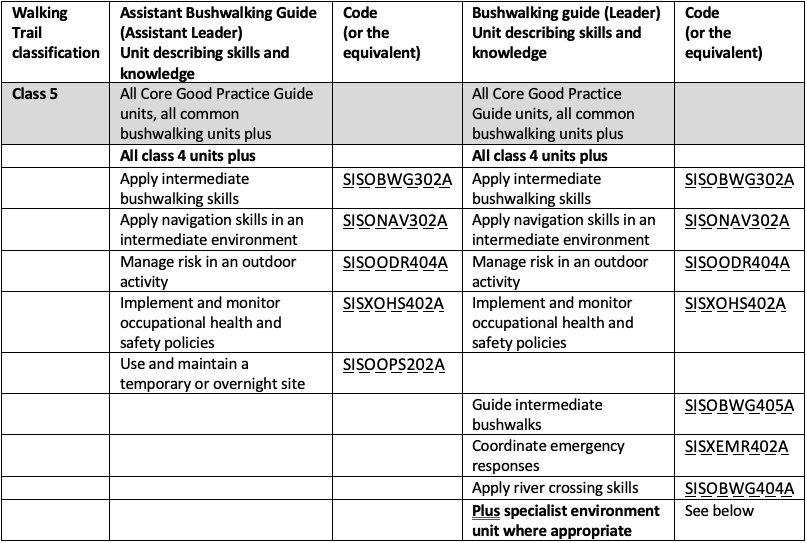Bushwalking Good Practice Guide
Guidance for day and overnight bushwalking and orienteering.
Version 1.0 | Date 23 Sept 2019 | Details: Version one release.
Acknowledgment, disclaimer and preface
Acknowledgment, disclaimer and preface
Traditional owner acknowledgement
The Outdoor Council of Australia and the Australian AAS Steering Committee would respectfully like to acknowledge the Traditional Owners, their Elders past, present and emerging, for the important role Indigenous people continue to play in Australia and most especially on the land and waters used for outdoor activities and recreation.
Disclaimer
Copyright
Copyright 2019 Outdoor Council of Australia.
Disclaimer
The information published in the Australian Adventure Activity Standard (AAAS) and accompanying Good Practice Guides (GPG’s), including this document, is for information purposes only and is not a substitute for, or intended to replace, independent, professional or legal advice. The information contained in the Australian Adventure Activity Standard and the Good Practice Guides are a guide only. Activity providers and any other person accessing the documentation should consider the need to obtain any appropriate professional advice relevant to their own particular circumstances, including the specific adventure activities and needs of the dependent participants.
The information published in the Australian Adventure Activity Standard and Good Practice Guides are subject to change from time to time. Outdoor Council of Australia gives no warranty that the information is current, correct or complete and is not a definitive statement of procedures. Outdoor Council of Australia reserves the right to vary the content of the Australian Adventure Activity Standard and/or Good Practice Guides as and when required. Activity providers should make independent inquiries as to the correctness and currency of the content and use their own skill and care with respect to their use of the information.
The Australian Adventure Activity Standard and Good Practice Guides do not replace any statutory requirements under any relevant State and Territory legislation and are made available on the express condition that Outdoor Council of Australia together with the authors, consultants, advisers and the Australian Adventure Activity Standard Steering Committee members who assisted in compiling, drafting and ratifying the documents:
- are not providing professional or legal advice to any person or organisation; and
- are not liable for any loss resulting from an action taken or reliance made on any information or material contained within the Australian Adventure Activity Standard, Good Practice Guides and associated documents.
Preface
Forward
“Adventure is worthwhile” – Aristotle
The Australian Adventure Activity Standard and Good Practice Guides are designed to ensure effective, responsible, sustainable and safe delivery of adventure activities to dependent participants. They can help people across the outdoor sector to develop appropriately managed adventure activities which enhance individuals and our communities, while protecting the environment and culturally significant places. In doing this, these documents can help ensure that people will continue to enjoy the benefits of adventure activities well into the future.
Best wishes for all your adventures.
The Australian Adventure Activity Standard Steering Committee.
About these documents
The Australian Adventure Activity Standard (AAAS) and related Good Practice Guides (GPG’s) are a voluntary good-practice framework for safe and responsible planning and delivery of outdoor adventure activities with dependent participants.
The AAAS and related GPG’s provide guidance on safety and other aspects of responsible activity delivery, such as respect for the environment, cultural heritage and other users. They are not a full legal compliance guide, nor are they a “how to” guide or field manual for outdoor activities. They do not provide guidance on providing a high-quality experience over and above safe and responsible delivery.
Activity providers are encouraged to obtain independent professional and legal advice in relation to their obligations and duties in delivering adventure activities and should reference the relevant laws to the area in which they intend to undertake the adventure activity.
Does the Standard and Good Practice Guides apply to me?
The AAAS and related GPG’s are specifically designed to help activity providers who are conducting activities involving dependent participants, to provide a safe and responsible experience. It is for each provider to determine based on their own individual circumstances, if they are working with dependent participants or not.
A dependent participant is a person owed a duty of care by the activity provider who is reliant upon the activity leaders for supervision, guidance or instruction to support the person’s participation in an activity. For example, this often includes participants under the age of 18, participants lacking the ability to safely undertake the activity, or participants reasonably relying on the activity provider for their safety. The degree of dependence may vary during an activity.
Considerations for determining if a person is a dependent participant may include, but is not limited to:
- the foreseeable level of competence of the participant in the activity and the associated level of reliance this creates on the activity leaders
- the level of foreseeable self-reliance of the participant to reasonably manage their own safety
- the possible variation throughout the activity of the level of reliance
- the variation of the degree of dependence throughout the activity
- the individual context, nature and circumstances of the activity
- the relevant circumstances and particular facts relating to the responsibilities assumed by the provider.
An activity provider can be any organisation – business, community group, government agency, school or any other groups – that organises and leads adventure activities. Individuals can also be an activity provider, if they have the ultimate legal duty of care to participants. In general, ‘the Standard’ and GPG’s relate to a provider as a ‘whole organisation’, rather than to ‘specific roles’ within the provider ‘organisation’.
Some providers may have their own standards or guidelines appropriate to their duty of care. It is recommended that these be reviewed periodically to ensure current duty of care expectations are met. ‘The Standard’ and ‘GPG’s’ may aid such reviews.
Are they legally binding?
The AAAS and GPG’s are voluntary, not legal requirements. However, they may refer to specific laws and regulations which may be legally binding on activity providers.
While the AAAS and ‘GPG’s’ are voluntary, some land managers and other organisations may require compliance. This may be as a condition of obtaining a licence, permit or other permission, or some other condition (e.g. a contract).
Under Australian common law and relevant legislation, providers have a legal duty of care towards dependent participants in some circumstances. In broad terms, the legal duty requires providers to take reasonable care that their actions and omissions do not cause reasonably foreseeable injury to dependent participants.
The AAAS and GPG’s are not legal advice, and they cannot answer whether a legal duty exists in specific circumstances. All adventure activity providers should check what legal requirements apply in their own situation and seek legal advice if at all in doubt.
Even in cases where participants are not dependent, other legal duties and obligations may arise. The AAAS and GPG’s have not been developed for those contexts.
Structure of the Standard and Good Practice Guides
The AAAS (i.e. the Standard) has a related Core Good Practice Guide (Core GPG). They both include guidance that applies to all adventure activities. They set out recommendations for a common approach to risk management that can generally apply regardless of the specific activity being undertaken.
Individual activity Good Practice Guides include guidance on specific adventure activities.

For any given activity, (i) the AAAS (the Standard), (ii) the Core GPG and (iii) the activity Good Practice Guide that applies to that specific activity, should be consulted.
The AAAS and Core GPG cover only those activities specifically listed. While the AAAS and Core GPG may be useful in managing risk generally for other activities, they may not reflect good practice for such other activities.
Interpretation of the Standard and Good Practice Guides
The following words and phrases are used in all documents and have specific meanings:
- Must: used where a provision is mandatory, if the provider is to operate fully in accordance with AAAS or GPG’s. (This is equivalent to the keyword “shall” used in other voluntary standards e.g. Standards Australia, other International Standards Organisations (ISO’s) etc.)
- Should: used where a provision is recommended, not mandatory. It indicates that the provider needs to consider their specific situation and decide for themselves whether it applies or is relevant.
- Can/cannot: indicates a possibility and capability.
- May/need not: indicates a permission or existence of an option.
- But are/is not limited to: used to indicate that a list is not definitive and additional items may need to be considered depending on the context.
The following formatting is used throughout:
- Defined words are in italics. They are defined in the Glossary.
- Examples are in smaller italic 9-point font.
- In document references are in underlined. References are to section heading titles.
- External web or Australian AAS & GPG document links are in dotted underline italic.
Creation
The AAAS and GPG’s were developed with the input from a wide range of outdoors and adventure activity experts with extensive field experience. They draw on state and territory-specific standards previously in place across Australia. The development process included work by a range of technical expert working groups, as well as open consultation throughout the community of activity providers and other experts.
The Steering Committee wishes to thank all the Technical Working Group (TWG) members for their work and contributions.
The Steering Committee acknowledges all the State and Territory Governments for funding the creation of the first national adventure activity standard and set of good practice guides for the sector.
Further details of the creation of the AAAS and GPG’s can be found at australianaas.org.au/about/history/
It is intended that the AAAS and GPG’s will be regularly updated to reflect changing practice and better understanding over time. Updates will be noted on the website www.australianaas.org.
1 Introduction
1.1 Bushwalking Overview
Bushwalking is walking in predominately natural areas. This may be for a short period of time for example, a few hours or an extended period requiring overnight camping.
Bushwalking can occur in a diverse range of environments/natural areas including but not limited to:
- coastal
- plains
- forest
- arid or outback
- tropical
- mountain or alpine.
1.2 Exclusions
This activity GPG is not generally applicable to day walks using class 1 and 2 walking trails in non-remote areas.
1.3 Related activities
Where camping occurs on a bushwalk, the Camping GPG must be complied with.
Consideration of the Bushwalking GPG should occur when conducting rogaining & orienteering activities with dependent participants.
2 Management of risk
Refer to the Core Good Practice Guide – Management of risk.
2.1 Management of risk
There are no additional specific activity provisions other than Core GPG provisions
3 Planning
3.1 Activity plans
Bushwalking specific planning considerations may include but are not limited to:
- the required navigation skills & equipment
- the suitability of maps for navigation
- what the intended route is
- identifying suitable sites to camp
- what terrain will be encountered on the route
- where sources of drinking water are
- the access to start & finish locations and throughout the activity.
- the impact of current seasonal factors
- identifying route specific hazards and risks
- determining the expected trail classification
- the expected weight of equipment activity leaders and participants need to carry
- having reasonable access in the initial stages, to enable practical assessment of participant’s abilities so that in cases where the participant’s ability does not match that needed to complete the activity, they can leave or withdraw without significant difficulties.
3.2 Emergency management planning
A non-participating contact must be used as part of the emergency management plan for:
• class 4, 5 and 6 bush walks
• remote bush walks
• overnight bush walks.
4 Participants
4.1 Information provided pre-activity
Pre-activity information given to participants should clearly communicate:
• the estimated overall backpack weight that a participant is likely to carry
• the equipment the provider will or can supply
• what equipment, clothing or footwear the participant needs to supply
• any necessary guidance as to the weight, size or type of equipment, clothing or footwear the participant needs to supply.
An appropriate pre-activity assessment should be completed to ensure participants meet the necessary requirements to carry the overall backpack weight that they are likely to carry.
5 Environment
5.1 Environment related planning
Other environmental considerations other than climate or weather for bushwalking may include but are not limited to:
- e.g. impeding progress, ability to cut or scratch etc.)
- e.g. risks associated with venomous snakes, ants etc.)
- e.g. steep slopes, uneven or unstable footing, cliff edges etc.).
5.1.1 Weather information
Refer Appendix 3 – Weather information.
5.1.2 Severe weather triggers
Trigger points must be based on the relevant Bureau of Meteorology weather warnings and actual weather conditions.
The risk management plan and emergency management plan should include guidance on trigger points and associated actions for:
- severe weather warnings
- thunderstorm warnings
- coastal waters wind warnings
- tropical cyclone advice: watch and warning
- extreme cold temperature
- extreme hot temperatures.
Actions for relevant weather may include but are not limited to:
- cancellation
- modification and/or evacuation to a safe location
- avoiding locations affected by tides or surf
- avoiding areas and river crossings that have the potential for flash flooding
- preparations to avoid the risks associated with blizzards
- moving to areas that are protected from strong winds
- managing risks of flying or falling items during strong winds
- moving to areas that are protected from hail
preparations to avoid the risks associated with lightning
5.2 Bushfire, prescribed fire and fire danger
Refer Core GPG – Bushfire, prescribed fire and fire danger.
5.3 Water crossing and flooding
The crossing of swollen creeks, rivers, flooded bridges or fords, or the entry of floodwaters should be avoided.
When assessing the suitability of a potential crossing, considerations should include but are not limited to:
- if there is debris floating or flowing in the current as this can indicate the risk of being hit and/or swept away by debris
- how clear the water is and if the base of the crossing be seen as this can help determine the depth of crossing and its base
- the depth of the crossing as this can indicate the amount of water and force needed to be overcome to avoid being washed away
- the speed of the water as this can indicate the volume of water and force needed to be overcome to avoid being washed away
- where the water flows as the flow may wash people into dangerous or deadly situations (e.g. into trees in the water that act as strainers, into narrow rock crevices)
- the base of the crossing (e.g. pebbles, sand, small rocks or large rocks) as moving water can move the base increasing the danger of foot entrapment and/or reducing the likelihood of maintaining stable footing during the crossing).
5.3.1 Flash flooding
When camping, locations likely to experience flash flooding should be avoided.
Areas likely to experience flash flooding should be avoided during severe weather or thunderstorms.
The suitability of water for drinking during and after flooding should be assessed.
5.4 Wildlife safety
Procedures should be in place to minimise the risks associated with wildlife that may be encountered.
The types of wildlife encounters that may need to be considered include but are not limited to:
- crocodiles
- snakes
- ticks
- wild pigs.
6 Equipment and logistics
6.1 Equipment requirements
Procedures must be in place to ensure appropriate clothing for the expected and foreseeable weather conditions is available.
Procedures must be in place to ensure appropriate footwear for the expected and foreseeable terrain is available.
Procedures must be in place to ensure a personal drink supply is available.
Procedures should be in place to ensure important equipment provided by participant(s) are appropriate for the activity context. Example equipment lists can be found in Appendix 2 – Common bushwalking equipment
6.2 Use of equipment
Training for the appropriate lifting, lowering and manual handling techniques for backpacks must be provided.
Training for the appropriate fitting and adjustment of backpacks must be provided.
7 Leadership
7.1 Naming conventions
The activity leader naming convention enables this activity GPG to be related to Core GPG requirements.
The leadership naming conventions for bushwalking activities are:
Bushwalking guide is equivalent to Leader in Core GPG.
Assistant bushwalking guide is equivalent to Assistant leader in Core GPG.
7.2 Competencies
7.2.1 Competencies overview
The Australian Adventure Activity Standard and Good Practice Guides refers to units from the Sport, Fitness and Recreation Training Package for descriptive statements of the knowledge and skills required of activity leaders.
The Training Package units are used for the sole purpose of providing descriptions for the knowledge and skills required. It is not intended to imply or require that specific formal training, assessment or qualification is the only means of gaining or recognising knowledge and skills.
Providers can recognise activity leaders as having the ‘ability to apply knowledge and skills to achieve expected results’ (i.e. competencies) in a number of different ways as detailed in the Core GPG – Recognition of competence.
The Training Package units listed can be found by searching for the units on the training.gov.au/Home/Tga website. The code provided with the unit name assists in this search.
7.2.2 Bushwalking competencies
Also refer to Core GPG – Competencies section.
Providers must determine the competencies required by activity leaders based on the context of the activity.
Refer Appendix 4 – Bushwalking leader competencies for recommended leader competencies for the different walking trail classifications.
For activities that involves overnight camping also refer to the Camping GPG.
7.2.3 Recognition of competence
Refer to considerations for recognition pathways outlined in Core GPG.
7.3 Group size
The following table outlines the maximum group size that should be used when leading bushwalks for specific classes of bushwalks.
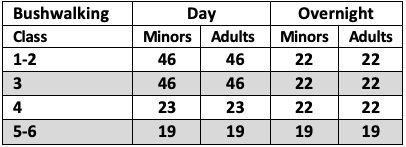
Also refer to the Core Good Practice Guide – Recognition of competencies.
7.3.1 Bushwalking minimum group size
The recommended minimum group size should be three for class 4, 5 and 6 bushwalks.
7.4 Activity leader to participant ratios
7.4.1 Supervision considerations
Supervision ratios are dependent on the activity context and a range of considerations.
Prior to determining ratios, providers must consider the recommended supervision ratios provide in this document and considerations on Core GPG sections:
- Activity leader to participant ratios
- Land owner, land manager and other authorities’ activity leader ratios
- Land owner and/or land manager requirements
- Environmental sustainability principles
- Environmental sustainability procedures.
The following tables outline the supervision ratios that should be considered when deciding the leadership requirements for specific bushwalk classes.
7.4.2 Supervision recommendations for minors

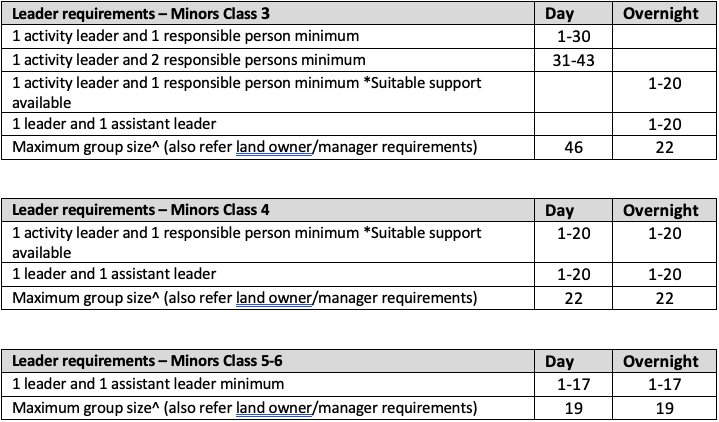
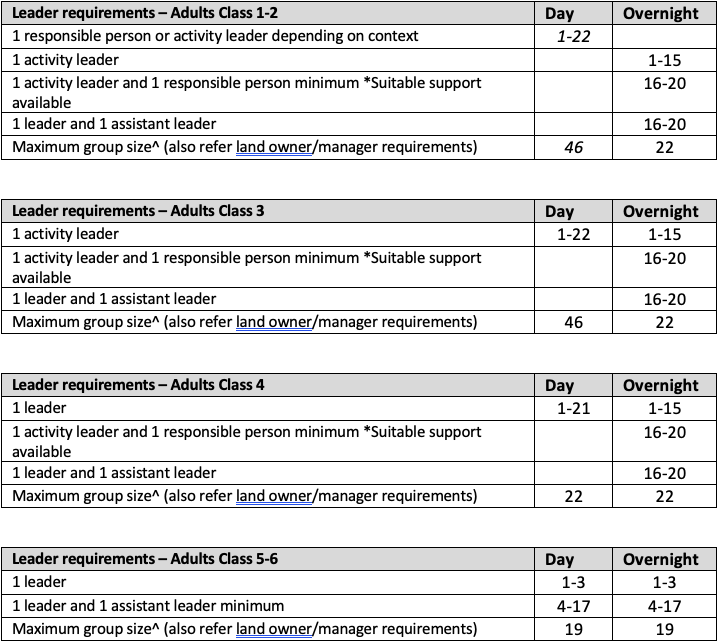
7.4.3 Supervision recommendations for Adults
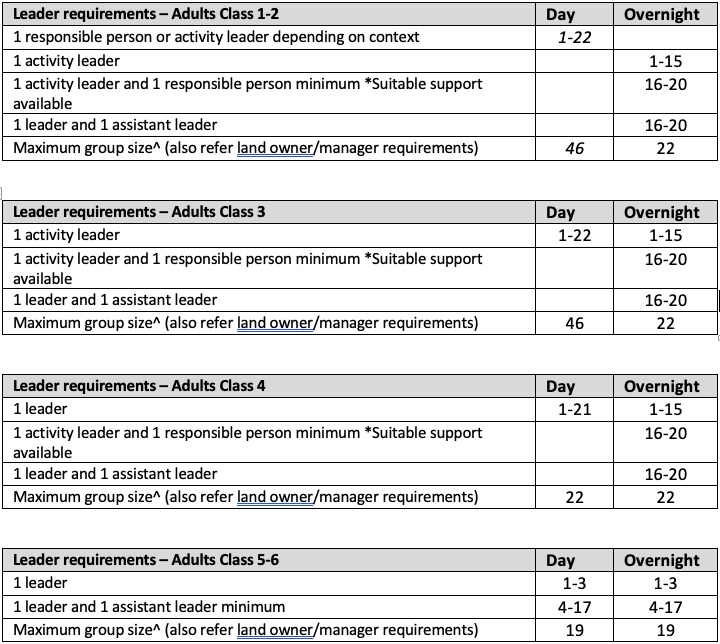
Responsible person(s) should have a first aid qualification.
Table Notes:
^Maximum group size = total of all activity leaders plus responsible persons plus participants.
*Suitable support available: Providers considerations for operating with only 1 activity leader include but are not limited to:
- factors identified in Core GPG – Activity leader to participant ratios & Land owner, land manager and other authorities’ activity leader ratios
- the skills and knowledge of the responsible person
- what nearby suitable support the provider has that can reach the group within a reasonable response time.
7.5 Supervision and management during the activity
7.5.1 supervision and management
Procedures should be used to reduce the potential of participants becoming separated or lost.
7.5.2 Rogaining & orienteering supervision
Where dependent participants may not have activity leader direct or indirect supervision for parts of the activity, refer to the following sections of the Core GPG:
- remote supervision
- indirect and remote supervision instructions considerations
- leadership of training activities.
Also refer to the Core Good Practice Guide – Recognition of competencies.
Glossary
Glossary
AAAS: Australian Adventure Activity Standard – See Preface for details.
Assistant bushwalking guide: is an Assistant Leader for a bushwalking activity
Bushwalking: walking in natural areas
Bushwalking guide: is a Leader for a bushwalking activity.
Camping: the use of a temporary site for overnight camping.
Day walks: bushwalking that has the intention and expected results of being completed without the need for camping or sleeping overnight.
Flash flooding: is flooding in a localised area with a rapid onset, usually as a result of relatively short intense bursts of rainfall.
GPGs: Good Practice Guide(s) – See Preface for details.
Trigger point: a particular circumstance or situation that causes an action to occur.
Also refer to the Core Good Practice Guide – Glossary.
Appendices
Appendix 1 Walking trail classifications
Class 1:
Tracks provide opportunities for large number of visitors, including those with reduced mobility, to traverse the natural environment easily. They provide high level of interpretation and facilities. Steps allowed only with ramp access. Users need no previous experience and are expected to exercise normal care regarding their personal safety.
Class 2:
Tracks provide opportunities for large numbers of visitors to walk easily in natural environments. They provide moderate to high level interpretation and facilities. They are generally on low gradients. Users need no previous experience and are expected to exercise normal care regarding their personal safety.
Class 3:
Tracks provide opportunities for visitors to walk in slightly modified natural environments requiring a moderate level of fitness. They provide low level of interpretation and facilities. Users need no bush walking experience and a minimum level of specialised skills. Users may encounter natural hazards such as steps and slopes, unstable surfaces and minor water crossings. They are responsible for their own safety.
Class 4:
Tracks provide opportunities for visitors to explore and discover relatively undisturbed natural environments along defined and distinct tracks with minimal (if any) facilities. They provide minimal interpretation and facilities. Users can expect opportunities for solitude and few encounters with others. Users require a moderate level of specialised skills such as navigation skills. Users may require maps and navigation equipment to successfully complete the track. Users need to be self-reliant, particularly in regard to emergency first aid and possible weather hazards.
Class 5:
Tracks provide opportunities for visitors with outdoor skills to discover the natural environment. Visitors require a higher degree of specialised skills such as navigation skills. Users may require maps and navigation equipment to successfully complete the track. Users need to be self-reliant, particularly in regard to emergency first aid and possible weather hazards.
Class 6:
Users require previous experience in the outdoors and a high level of specialised skills such as navigational skills. Users will generally require a map and navigation equipment to complete the track. Users need to be self-reliant, particularly in regard to emergency first aid and possible weather hazards.
The above classifications come from the Australian Standards 2156.1-2001: Walking tracks – Classification and signage.
A detailed review of the Australian Standards 2156.1-2001: Walking tracks – Classification and signage can be downloaded from http://www.parks.tas.gov.au/file.aspx?id=36771
Appendix 2 Common bushwalking equipment
The equipment required and the appropriate “type” of equipment used is dependent on the specific context of the activity.
Equipment used for bushwalking may include but is not limited to:
Emergency/rescue
- documentation (see Core GPG – Activity leader required documentation)
- emergency communication equipment (see Core GPG – Emergency communication)
- first aid kit in waterproof storage (see Core GPG – First aid equipment and medication)
- a waterproof method of storing and carrying documentation and communications equipment
- specific activity context equipment required
- emergency shelter where appropriate for the context
- emergency equipment to keep a patient warm (e.g. mat, sleeping bag) where appropriate for the context
- signalling device(s) (e.g. mirror, flares)
Activity Leaders
- communications equipment (standard communication rather than emergency communication where this differs) and spare batteries or backup “power banks”
- relevant maps and navigation information
- a waterproof method of storing and carrying maps and navigation information
- compass and/or other navigation aids (e.g. GPS)
- pen/pencil and blank writing paper
- watch or equipment suitable to tell and measure time for first aid purposes
- head torch and spare batteries
- appropriate spare equipment
- appropriate repair equipment
- same as for participant
Participant
- personal medications (including for asthma and anaphylaxis)
- personal hygiene requirements
- whistle
- strong backpack, suitably sized and adjusted
- waterproof pack liner
- water containers
- jumpers
- thermals
- beanie or balaclava
- sun hat
- raincoat suitable for the environment
- overpants
- footwear suitable for the conditions
- suitable socks
- shirt with collar and preferably long sleeves
- strong shorts or trousers
- underwear
- gloves
- light garden gloves
- handkerchief
- pocket knife
- sock covers or gaiters
- sunglasses
- spare prescription glasses
- walking pole(s)
- sit mat
- high visibility vest
- sunscreen
Group
- trowel for toileting
- toilet paper
- hand sanitiser
- water purification system
- repair kit
- food for duration plus spare
- rubbish bags
- multi-tool with knife
- sunscreen
- insect repellent
Repair equipment
- buckles
- needle and thread
- duct tape
- multi tool
- multi-purpose glue
- tent pole repair tubes
- sleeping mat repair kit
Refer Core GPG for first aid kit common content.
Additional equipment used for overnight or extended duration walks may include but is not limited to:
Emergency or rescue
- emergency fire lighting equipment appropriate to the activity and location
Activity Leaders
- as per participant
Group
- appropriate shelters (e.g. tent)
- cooking equipment and ‘lifters’ for pots
- cleaning equipment for catering equipment
- cooking stove and fuel
- matches/lighter
- glow sticks, spare batteries, candles
Participant
- small torch and spare batteries
- sleeping bag in waterproof bag
- eating utensils such as cutlery, bowl, plate and cup
- spare clothing
- spare shoes for camp
- sleeping mattress.
Appendix 3 Weather information
The Bureau of Meteorology also provides a range of services. For details refer to:
http://www.bom.gov.au/weather-services/WeatherGuideLand.pdf
The following table details the:
• current Australian weather warnings
• associated weather for each warning
• mainland warning trigger points for issuing warnings for strong winds and hail.
Bureau of Meteorology weather warnings and associated weather Table:
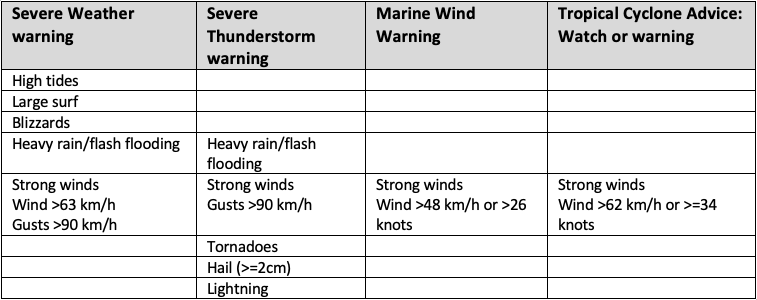
Appendix 4 Bushwalking leader competencies
The following table outlines the recommended competencies activity leaders should have when leading bushwalking for specific walking trail classes.


